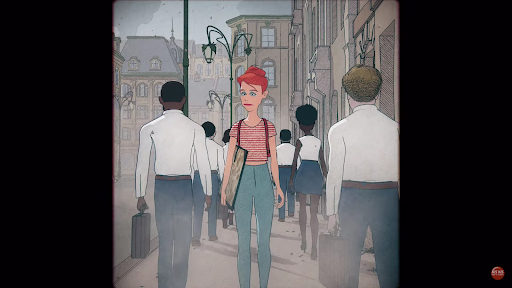
Dark smoke smothers the sky; dirt and ashes twirl down like falling leaves; city dwellers shuffle on the barren streets, wheezing and coughing. Dutch filmmaker Arjan Brentjes’s animated film, “Sad Beauty,” depicts a heavily-polluted world where species go extinct every day, leading viewers to think this is yet another film featuring the ecological anxiety that highlights threatening environmental problems. But, as the story unfolds, it reveals a more profound message from the natural world.
Set in an unnamed city trapped in choking, contaminated air, the story follows a young woman’s daily routine—watering a droopy potted plant while TV news plays in the background, heading to a natural history museum and drawing extinct butterflies in the exhibition room. From her point of view, we see the increasingly decaying surroundings and the spread of a deadly airborne disease. From the news that she watches, we learn about the extinction of animal species and the outbreak of a pandemic of bacteria that resist antibiotics. Throughout all of these, contagious bacteria proliferate in the body of the protagonist, making her one of the victims of the pandemic.
The film doesn’t follow the predictable storyline of how climate collapse spells utter ruin for human beings and numerous other species. Instead, as the woman is dying, nature delivers a message in her hallucination, guiding her to realize that life will go on beyond the current species and that bacteria, as the basis of life, will carry on the energy and create new forms of life. The fresh perception of the natural world brings solace to the protagonist and an unexpected resolution to the tense situation.
Throughout the film, Brentjes renders the omnipresence of bacteria, paving them at every major step of the story. At the very beginning, single-celled organisms swarm in the background as the film title appears on top of them, foreshadowing their significance later on. As the plot progresses, the presence of bacteria evolves from subtle illustrations, such as a brief close-up shot on the televised news, to a dramatic spectacle of zillions of bacteria gathering and collapsing repeatedly—an embodiment of the departure and return of life on earth in a continuous cycle.
The film, although less than 10 minutes long, does a solid job of evoking the grimy dystopian milieu vividly portrayed by the narrative. All throughout the film, except for the announcement of recently extinct species on TV, there is no dialogue, inner thoughts or voiceover; the viewers rely on the scenes, the character’s appearance, body language, reactions and soundtracks to receive the message. The music constantly creates uneasy anticipation, adding an extra layer of foreboding.
“Sad Beauty” is not a joyous film nor an agonizing one. It is a film that carries a sense of weighty reality without falling into a grim tone of wrath and despair. While it is sad to envisage humans will disappear from the planet someday, it comes as a relief to know that even without humans, nature will find its way. The planet will recover and become lush and diverse again, and that is beautiful.


































